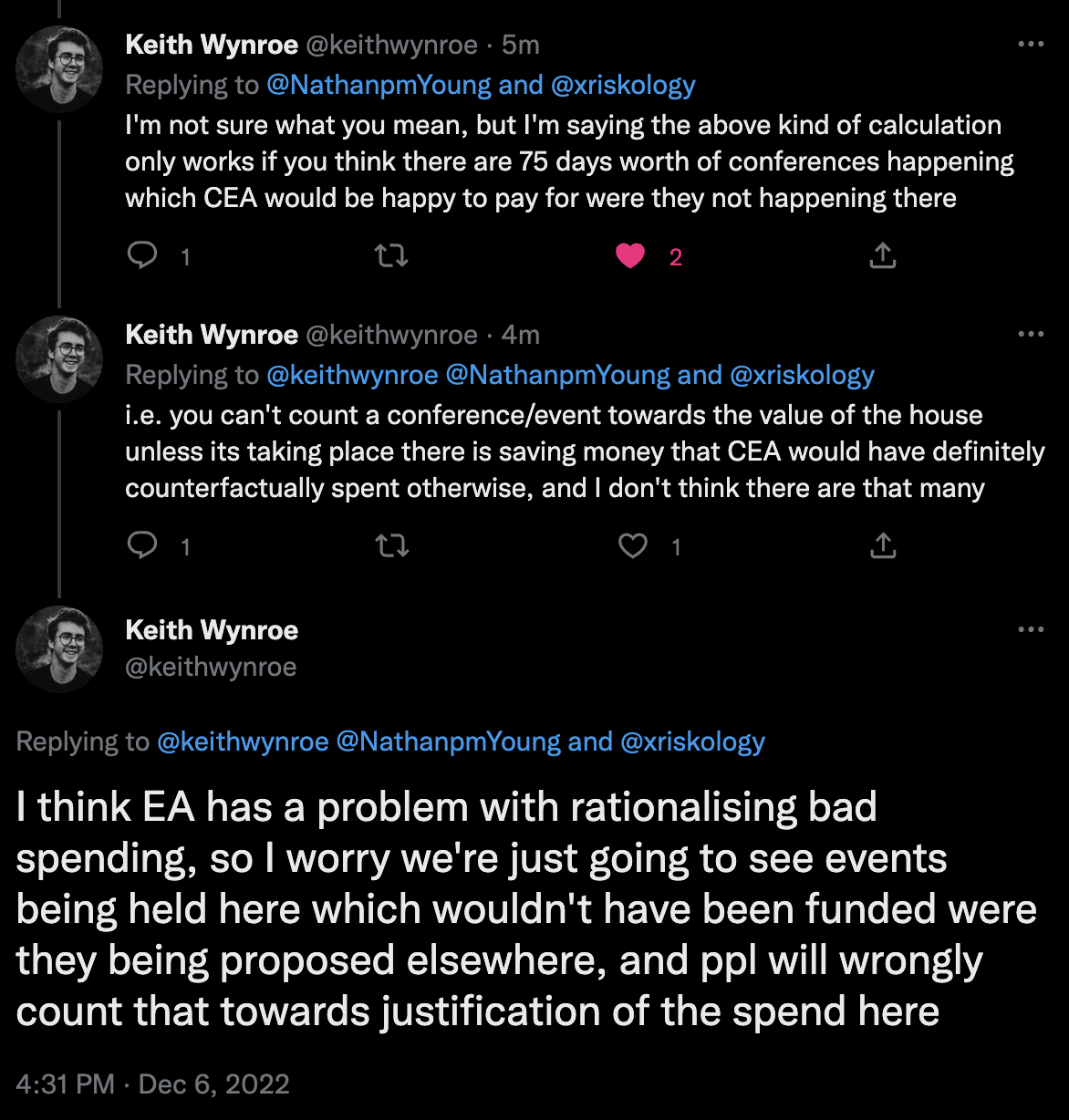Edit to add (9/1/2023): This post was written quickly and I judged things prematurely. I also regret not reaching out to Effective Ventures before posting it. Regarding my current opinion on the Abbey: I don't have anything really useful to say that isn't mentioned by others. The goal of this post was to ask a question and gather information, mostly because I was very surprised. I don't have a strong opinion on the purchase anymore and the ones I have are with high uncertainty. More thoughts in my case for transparent spending.
Yesterday morning I woke up and saw this tweet by Émile Torres: https://twitter.com/xriskology/status/1599511179738505216
I was shocked, angry and upset at first. Especially since it appears that the estate was for sale last year for 15 million pounds: https://twitter.com/RhiannonDauster/status/1599539148565934086
I'm not a big fan of Émile's writing and how they often misrepresent the EA movement. But that's not what this question is about, because they do raise a good point here: Why did CEA buy this property? My trust in CEA has been a bit shaky lately, and this doesn't help.
Apparently it was already mentioned in the New Yorker piece: https://www.newyorker.com/magazine/2022/08/15/the-reluctant-prophet-of-effective-altruism#:~:text=Last year%2C the Centre for Effective Altruism bought Wytham Abbey%2C a palatial estate near Oxford%2C built in 1480. Money%2C which no longer seemed an object%2C was increasingly being reinvested in the community itself.
"Last year, the Centre for Effective Altruism bought Wytham Abbey, a palatial estate near Oxford, built in 1480. Money, which no longer seemed an object, was increasingly being reinvested in the community itself."
For some reason I glanced over it at the time, or I just didn't realize the seriousness of it.
Upon more research, I came across this comment by Shakeel Hashim: "In April, Effective Ventures purchased Wytham Abbey and some land around it (but <1% of the 2,500 acre estate you're suggesting). Wytham is in the process of being established as a convening centre to run workshops and meetings that bring together people to think seriously about how to address important problems in the world. The vision is modelled on traditional specialist conference centres, e.g. Oberwolfach, The Rockefeller Foundation Bellagio Center or the Brocher Foundation.
The purchase was made from a large grant made specifically for this. There was no money from FTX or affiliated individuals or organizations." https://forum.effectivealtruism.org/posts/Et7oPMu6czhEd8ExW/why-you-re-not-hearing-as-much-from-ea-orgs-as-you-d-like?commentId=uRDZKw24mYe2NP4eq
I'm very relieved to hear money from individual donors wasn't used. And the <1% suggests 15 million pounds perhaps wasn't spent. Still, I'd love to hear and understand more about this project and why CEA thinks it's cost-effective. What is the EV calculation behind it?
Like the New Yorker piece points out, with more funding there has been a lot of spending within the movement itself. And that's fine, great even. This way more outreach can be done and the movement can grow. But we don't want to be too self-serving, and I'm scared too much of this thinking will lead to rationalizing lavish expenses (and I'm afraid this is already happening). There needs to be more transparency behind big expenses.
Edit to add: If this expense has been made a while back, why not announce it then?


The lack of a 2 hour commute is nothing to sneeze at though. CFAR has (had? I haven't checked in on it lately) a venue a couple of hours away from Berkeley that they've used for organizing workshops and events, and the tribulations of organizing getting everyone to and from the venue pretty much ensured it was only used for running 4-5 day events. It made it significantly more difficult for folks at CFAR or MIRI to pop up to make "guest appearances" at workshops and the like significantly reducing value to participants.
Speaking from personal experience, that distance rather complicated the value proposition for me, for whether it was worth showing up for a day at the end of an event to get to know some of the participants.
At the end of the day, the optics seem poor, but the actual cost for the space seems to be what I'd expect for a space that can sleep that many people, zoned so you can use them as actual bedrooms and have people stay on site. By the time it is kitted out in proper group-house density with beds in every nook and cranny you can find, you'd be able to fit a rather large number of attendees into the space.
You can go grab some concrete office space in an industrial park somewhere, but at the end of the day you generally can't legally have people sleep in that office space -- no matter what Elon is trying to do with Twitter HQ this month, so you'd wind up needing to sublet nearby apartments and the like for attendees, assuming you can find ones that legally allow you to do so, or pay premiums for hotel stays.
Part of why the CFAR venue wound up as far outside of Berkeley as it did, was they literally couldn't find any place closer that would legally let them treat it like a bed and breakfast for hosting attendees.
https://www.rationality.org/resources/updates/2017/cfar-2017-venue-update is an older post describing the rationale for purchasing the space I mentioned above.
Habryka and the rest of the Lightcone Infrastructure team seem to be wrangling the same sort of considerations as they try to provide gathering space for EA and rationalist folks in the bay area, today, except there a roughly equivalent amount of funding doesn't buy anything like a fancy-looking but run-down historical abbey.